When someone loses a limb, life changes in ways they never imagined. Simple things like getting out of bed, walking to the door, or even sitting comfortably become harder. But one thing offers hope, stability, and a return to independence—a well-fitted prosthesis. It’s more than a device. It’s a bridge between loss and new beginnings.
Yet, one of the most overlooked parts of this journey is timing. Many people don’t realise how important it is to begin the prosthesis fitting process at the right time. Delaying it—whether by weeks or months—can affect how quickly someone heals and how well they regain movement. It’s not just about walking again; it’s about how the body, and even the mind, responds during recovery.

The Body After Amputation: Why Early Action Matters
When a limb is lost, the body goes through a major change. It’s not just the missing arm or leg. Everything connected to that limb—muscles, joints, nerves, blood vessels, and even posture—begins to adjust.
The human body is smart. It tries to find new ways to balance and move. But without proper support, this natural adjustment can lead to bigger problems.
Muscles Begin to Weaken Quickly
The muscles that used to support the missing limb don’t get used in the same way anymore. If they’re not activated or trained early, they begin to shrink.
This process is called muscle atrophy. It can happen faster than most people realise. Within a few weeks of little or no movement, strength begins to fade.
When a prosthesis is fitted on time, it helps activate those muscles again. Even small movements like standing or shifting weight with the help of a prosthesis keep the muscles alert.
But if fitting is delayed, the body gets used to not using those muscles, which makes later movement harder and more tiring.
And it’s not just the muscles around the missing limb. The rest of the body has to adjust too. The hips, the back, and even the shoulders start working differently.
If the person isn’t walking or moving evenly, other muscles become overworked. This can cause stiffness, fatigue, or even pain in unexpected places.
Joints Lose Flexibility
Another challenge that comes with waiting too long for a prosthesis is joint stiffness. Joints are made to move. When they stay in one position for too long—like bent knees or tight hips—they begin to lose their range of motion.
This means it becomes harder to straighten the leg or lift the hip. These changes might seem small at first but can have a big impact on how a person walks later on.
A stiff joint can make prosthetic fitting more complicated. The device might not sit properly or move naturally. In some cases, the stiffness becomes so severe that the person can’t use a prosthesis comfortably at all without weeks of extra therapy—or even another surgery.
Early physical therapy and timely fitting can prevent this. When a prosthesis is introduced during the healing window, it keeps the joints in motion. Even small movements help maintain flexibility and support a smoother recovery.
The Residual Limb Starts to Change Shape
After amputation, the residual limb begins to change. At first, there’s swelling. Over time, the swelling goes down, and the limb starts to take on a more permanent shape. This process is natural, but it needs to be guided.
Doctors often use compression garments or wraps to help the limb take on a smooth, cone-like shape. This shape is ideal for fitting into a prosthetic socket. But if these tools are not used, or if the fitting is delayed, the limb can heal in a shape that’s harder to work with.
If the limb becomes round, uneven, or swollen in some areas, it can make prosthesis fitting painful or unstable. The socket may cause pressure points, discomfort, or skin irritation.
At that point, the prosthetist may need to wait even longer—or create custom solutions that take more time and money.
Early involvement of a prosthetist can help prevent these challenges. When fitting begins at the right time, the prosthetist can monitor the limb, make small adjustments, and prepare it for a smooth fit. This makes the eventual prosthesis more comfortable and easier to use.
Movement Patterns Become Set in the Brain
The brain plays a big role in recovery after amputation. It doesn’t just control movement—it remembers how the body moves. After losing a limb, the brain has to relearn how to balance, stand, and walk. The sooner this learning begins, the better.
When fitting is delayed, the brain starts to develop new movement patterns that aren’t always healthy. For example, a person might lean heavily on the other leg. Or they might sit for long hours to avoid moving at all. Over time, these habits become harder to break.
Once a prosthesis is finally introduced, the brain doesn’t just have to learn something new—it has to unlearn the old, unhelpful patterns. This makes the rehab process longer and more frustrating.
It can also affect confidence, making the person doubt whether they’ll ever move normally again.
But if the prosthesis is introduced early, the brain quickly adapts. It begins to include the prosthesis in its picture of the body. Movement feels more natural, and learning to walk becomes less about fixing mistakes and more about building progress.
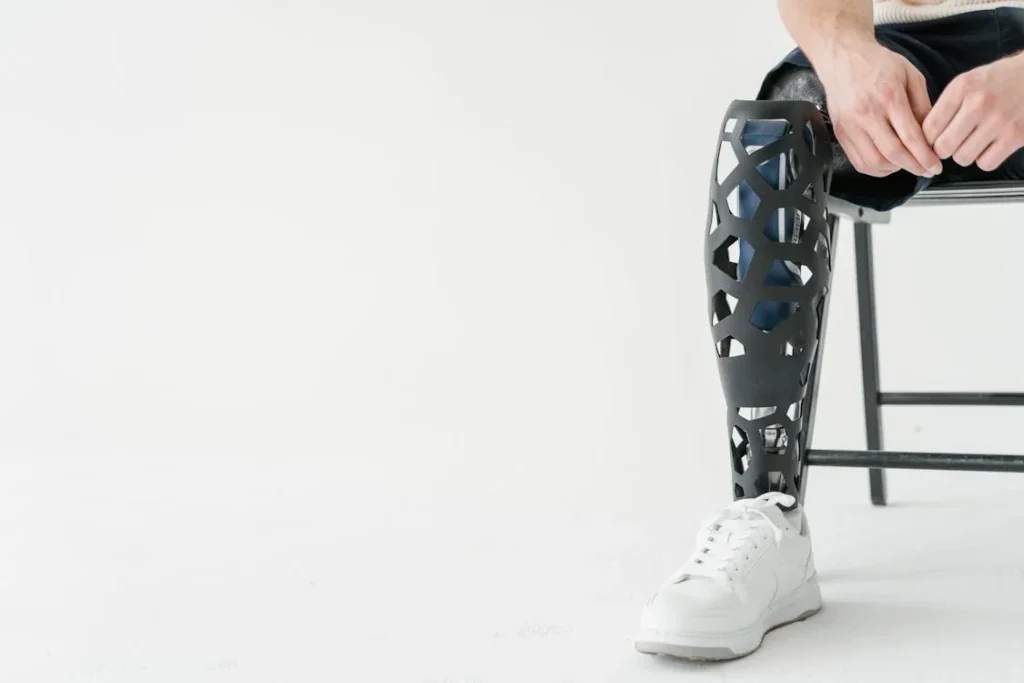
How Delays Affect Emotional Recovery and Motivation
Recovery after amputation is not just about the body. The emotional journey is just as important—and often, more fragile. When someone loses a limb, they also lose a part of how they saw themselves.
They may feel unsure about their place in the world, worried about how others see them, and uncertain about the future. Getting fitted for a prosthesis isn’t just about walking again—it’s about feeling whole again. And when that moment is delayed, it can change everything emotionally.
Losing Momentum Early On
Right after surgery, many people have a strong desire to get back on their feet. That energy is a powerful part of recovery. It drives them to do their therapy, care for their wound, and ask questions about their prosthetic options.
But if weeks go by without progress—if the prosthesis isn’t discussed or feels far away—that early spark can begin to fade.
It’s common to hear patients say, “I thought I’d be walking by now,” or “I didn’t expect to feel stuck.” That feeling of being stuck is one of the hardest parts of delayed fitting.
It can lead to frustration, sadness, or even withdrawal. When someone feels like nothing is happening, they stop trying. They may skip therapy sessions, ignore their exercises, or stop taking care of their residual limb.
All of this slows recovery even more. Not because the body can’t heal, but because the mind has lost interest. When someone loses that sense of progress, it becomes much harder to get it back.
The Risk of Depression and Isolation
Delays can also create emotional distance between the person and the life they used to live. They may avoid seeing friends or going out. They may stop doing the things they once enjoyed because they don’t feel ready—or don’t want others to see them “unfinished.”
Without a prosthesis, it’s easy to feel left out. Social events become harder. Moving around the house becomes a task. Even short outings feel like challenges.
Over time, these feelings build into something heavier. It’s not unusual for people facing long delays to experience depression or anxiety. They start to believe that life won’t improve.
What’s difficult is that these emotions are often invisible. From the outside, the person may seem calm or quiet. Inside, they’re struggling. And the longer the wait for a prosthesis, the deeper those feelings can become.
At Robobionics, we’ve worked with many patients who delayed their fitting and later shared how lost they felt during that time. They didn’t just need a device. They needed direction, reassurance, and a sign that progress was still possible.
Delayed Fitting Can Undermine Confidence
One of the most powerful benefits of a prosthesis is the confidence it brings. Even just standing upright again can make someone feel strong, capable, and proud. But if that moment doesn’t come soon enough, doubt can set in.
People begin to question whether they’ll ever walk again. They compare themselves to others. They start saying things like, “Maybe I’m not ready,” or worse, “Maybe I can’t do this.”
This mindset makes every next step harder. It makes therapy feel heavier. It creates hesitation when using the prosthesis later, which slows adaptation.
Some even begin to reject the idea of using a prosthesis at all—not because they don’t want it, but because they’re afraid of failure.
On the other hand, when fitting is timely, even small wins happen early. Those wins—taking a step, standing up, walking across the room—build belief. They prove that progress is possible.
Each success, no matter how small, tells the mind, “You can do this.” And that belief becomes fuel for the rest of the journey.
Support Feels Farther Away with Time
In the early days after surgery, the person is often surrounded by care—doctors, nurses, therapists, family. There’s a lot of attention, and that creates a sense of safety.
But as weeks pass, that circle can begin to shrink. Appointments become less frequent. Friends go back to their routines. Family members return to work. If the prosthesis hasn’t been introduced yet, the person may feel like they’ve been left behind.
This sense of being forgotten is painful. It makes recovery feel lonely. And the longer the prosthesis is delayed, the longer the person is left in that lonely place.
Some don’t speak up about it. They don’t want to bother anyone. They don’t want to seem ungrateful. So they stay silent, and their emotional load gets heavier.
Timely fitting keeps the momentum going. It keeps the support circle active. When patients see progress, they’re more likely to stay connected with their care team and their loved ones. They ask more questions, attend more sessions, and stay engaged with their goals.
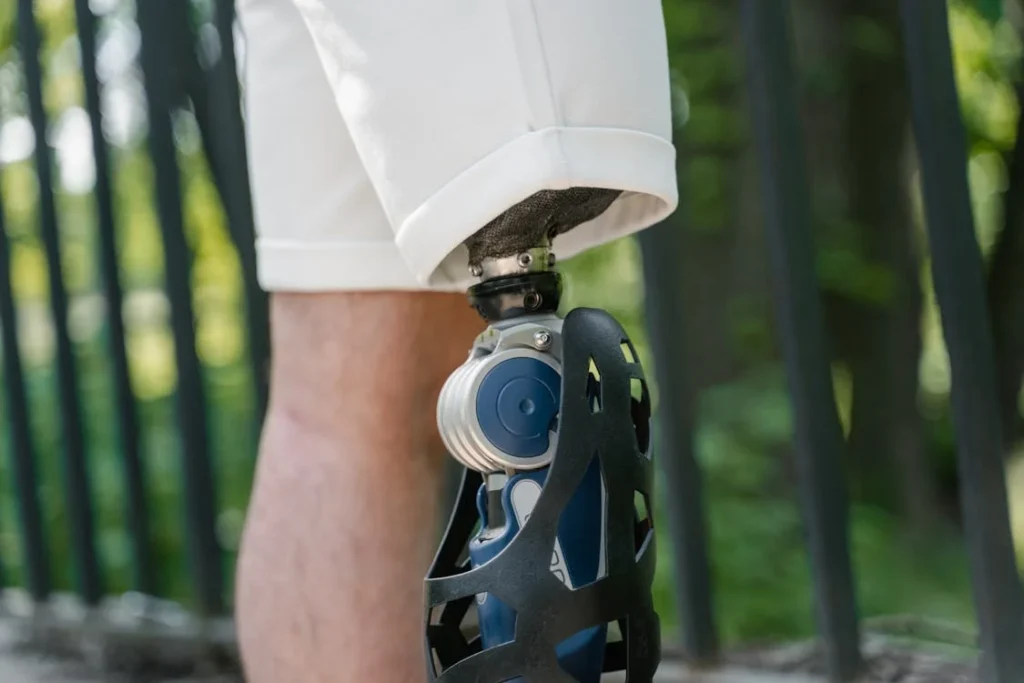
The Impact of Delay on Long-Term Mobility Goals
Regaining mobility is one of the biggest hopes most people hold after an amputation. The dream of walking again, of standing without help, of moving freely through the world—these are deeply personal goals.
But what many people don’t realise is that delays in prosthesis fitting can push those dreams further away. In some cases, they can even change what’s possible.
The longer someone waits to start walking again, the harder it becomes—not because of age or injury, but because of the way the body and mind adapt to inactivity.
The Window for Physical Readiness
There’s a sweet spot for starting prosthetic use. It’s not an exact day or week, but it usually falls within a few weeks to a couple of months after surgery.
During this time, the residual limb is healing well, the swelling is going down, and the joints and muscles are still relatively flexible. If the person is already doing some physical therapy, their body is more prepared for the challenges of walking with a prosthesis.
But when that window is missed—when prosthesis fitting is delayed far beyond this phase—the body begins to resist movement. Muscles shrink further.
Joints become tighter. The person may have spent weeks or months in a wheelchair or using walking aids. That means the body has adjusted to not bearing full weight, and the brain has accepted a more sedentary way of life.
At that point, mobility doesn’t just mean walking again. It means undoing all the compensations the body has made during the delay. It means retraining muscles, regaining balance, and building stamina from a lower starting point. That takes more time, more effort, and often more frustration.
Affecting the Quality of Gait
When prosthetic fitting is delayed, it doesn’t just slow progress—it can also change the way someone walks. An early fitting allows the body to develop good walking habits while the brain is still flexible and responsive.
It allows proper posture, even weight distribution, and natural stride patterns to form.
But a delayed fitting often comes after months of compensatory movement. Maybe the person leaned heavily on one side. Maybe they used their arms or back more than their legs.
These habits leave marks on the body, and they don’t go away easily. They show up in the way someone walks—with a limp, an uneven step, or a posture that puts stress on other joints.
This isn’t just cosmetic. Poor gait can cause pain in the hips, knees, or lower back. It can make daily walking uncomfortable or tiring. It can even damage the remaining limb if it’s bearing too much weight.
Over time, this leads to joint wear, discomfort, and a reduced desire to stay active.
Correcting gait issues later is possible, but it takes time and guided therapy. If the prosthesis is fitted early, and the person is walking with support and coaching from the start, these issues can be avoided or greatly reduced.
Challenges with High-Level Mobility Goals
For many amputees, the goal isn’t just to walk around the house. They want to get back to work, play sports, travel, and return to the life they had before. These high-level goals are possible—but they depend on how well the early recovery phase is handled.
When prosthesis fitting is delayed, the climb toward advanced mobility becomes steeper. The person may need to spend extra time just getting back to basic functions before they can even begin working on strength, endurance, or agility.
The timeline shifts forward, and the emotional energy required becomes much greater.
Some patients, especially those who had active lives before amputation, find this particularly frustrating. They want to move quickly, but their body is no longer ready to move at the same pace.
They may feel disappointed, angry, or discouraged by the time and effort needed just to return to what once felt easy.
But when fitting happens early, the path stays smoother. The person can begin light training, build their balance and coordination, and gradually push themselves further.
They don’t have to backtrack or re-learn old habits. Every step they take leads them closer to their goal—not further away from it.
Reduced Confidence in Mobility
Mobility isn’t just about the body—it’s also about confidence. Someone can have strong legs and a well-fitted prosthesis, but if they don’t trust themselves, they won’t walk far.
Delayed fitting often creates fear. Fear of falling, fear of pain, fear of not being able to move like before. This fear becomes a barrier. It keeps people close to home. It makes them turn down opportunities. It shrinks their world.
Early fitting builds confidence. Each step, no matter how small, proves that movement is possible. Each success—even just standing or walking a few meters—tells the brain, “You’re safe. You can do this.”
That kind of belief grows stronger over time, and it becomes the foundation for long-term mobility.
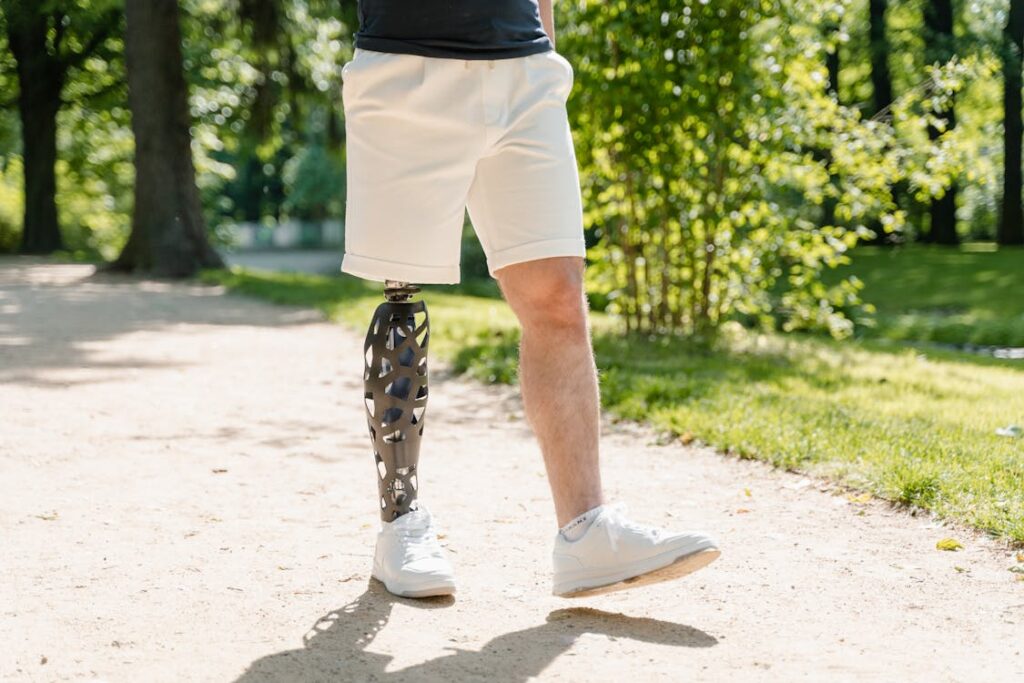
How Timely Intervention Can Reverse or Reduce Setbacks
Even if there’s been a delay in prosthesis fitting, not all is lost. The human body and mind are remarkably adaptable—especially when guided by the right care, attention, and tools. At Robobionics, we’ve worked with individuals who faced months of delay but still achieved great outcomes.
The key was timely intervention once they were back on track. Acting at the next best moment, even if the ideal window has passed, can still bring significant progress and prevent further complications.
Starting Where You Are, Not Where You Wish You Were
One of the first things we tell patients who feel behind is this: start where you are. Don’t compare your journey to someone else’s. Maybe you had a longer recovery. Maybe life circumstances delayed your fitting. What matters now is how you move forward.
That begins with a full evaluation. A prosthetist will examine the condition of the residual limb, assess joint movement, and measure muscle strength.
They’ll also talk to you about your goals—whether it’s walking with support, returning to work, or simply regaining independence in your daily routine.
From there, a step-by-step plan is created. The focus isn’t to rush into a full prosthesis, but to prepare the body again—through exercises, limb shaping, and sometimes therapy—to accept the prosthesis safely and comfortably.
Reconditioning the Body Through Guided Therapy
When a person has been inactive or off their feet for a long time, the body needs to relearn how to move efficiently. That doesn’t mean doing intense workouts or painful routines.
In fact, the best results come from slow, guided physical therapy that rebuilds the basics—balance, posture, joint movement, and light muscle activity.
A physiotherapist works alongside the prosthetist to help the patient strengthen the right muscles, loosen stiff joints, and improve endurance.
Even small routines, like standing for short periods or shifting weight from one foot to the other, begin to wake up the body’s memory of motion.
This stage may take time. But with consistency and proper support, patients can recover a great deal of strength—even after long periods of inactivity. It’s not about rushing. It’s about rebuilding, step by step.
Adapting the Prosthesis to Current Needs
If a person’s residual limb has changed shape due to delay, or if the skin has become more sensitive, a skilled prosthetist can still create a solution. There are materials and socket designs specifically made for people who’ve had delays or complications.
Soft liners, flexible socket walls, or adjustable suspension systems can reduce pressure and increase comfort. Modern technology allows for prosthetic adjustments even months after fitting. And if needed, a temporary prosthesis can be used to slowly reintroduce weight-bearing activities without causing pain.
The goal here is to meet the patient where they are—not just physically, but emotionally. If the body needs to move slower, the prosthesis should support that. If fear or hesitation exists, the device should feel secure and comfortable enough to rebuild trust.
Restoring Confidence One Step at a Time
The emotional side of recovery can’t be ignored during intervention. A person who has faced a delay often carries doubt. They may worry about falling behind. They may be afraid of pain. They may question whether a prosthesis will even work for them anymore.
At Robobionics, we believe that rebuilding confidence is as important as restoring mobility. That’s why we focus on small, early wins.
These are moments like walking a few steps with support, standing comfortably, or wearing the prosthesis for an hour without discomfort. Each of these victories shifts the mindset from fear to hope.
We also connect patients with others who’ve been through similar experiences. Peer support—whether in person or online—can be incredibly powerful. When someone sees that others have overcome similar delays, it helps them believe that they can too.
Preventing Future Setbacks
Once a person is back on track, the goal becomes maintaining momentum. That means regular follow-ups with the prosthetist, staying active, and paying attention to how the body responds.
It also means speaking up if something feels wrong—whether it’s pain, discomfort, or emotional stress.
Delayed fitting can teach patients to listen more closely to their own needs. It creates a deeper awareness of how the body works, and it helps them become active participants in their own care.
This self-awareness becomes a strength, and it helps prevent future issues before they grow into larger setbacks.
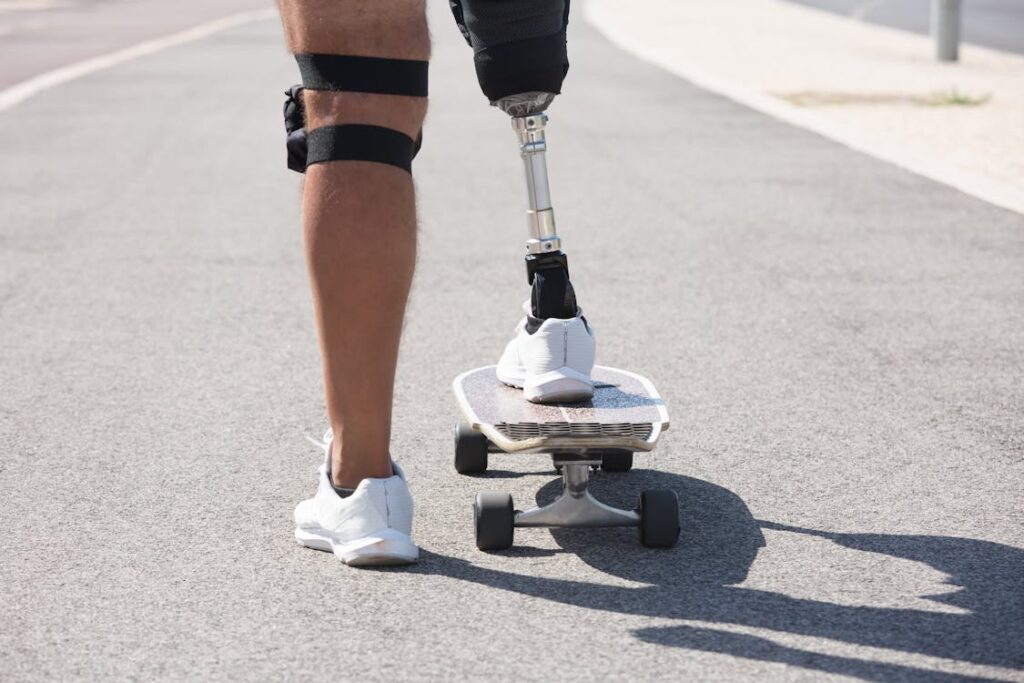
Practical Advice to Avoid Fitting Delays
While not every delay is avoidable, many are. In our experience at Robobionics, we’ve seen that the sooner a clear recovery plan is in place—one that includes prosthesis fitting as a key milestone—the smoother the journey becomes.
When you understand what steps to take, when to take them, and who to involve, you reduce the risk of being caught off guard by problems that could have been prevented. Let’s walk through some of the most helpful, real-world advice that can help you or your loved one stay on track.
Start Talking About Prosthetics Early
One of the biggest reasons people face delays is because they don’t know when to begin thinking about a prosthesis. Some wait for the wound to fully heal. Others wait for the doctor to bring it up. But early conversations with a prosthetist—even before full healing—can prepare the ground.
The best time to start discussing prosthetic options is within the first two to three weeks after surgery. This doesn’t mean you’ll get fitted right away. It simply means you’re bringing in the prosthetist early to observe healing, guide the shaping of the residual limb, and offer advice on what to expect next.
When the prosthetist becomes part of your care team early on, they can spot potential issues before they become barriers. This makes future fitting easier and helps avoid unnecessary waiting.
Follow Post-Surgery Instructions Closely
After amputation, your surgeon or physiotherapist will give specific instructions for limb care. These might include how to clean the wound, how to wrap the limb, how to wear compression socks, and how to perform light exercises.
These instructions are not just for comfort—they actively shape your limb for future prosthetic fitting. Skipping them, even for a few days, can lead to swelling, poor shaping, or infections that delay healing. On the other hand, consistent care means the limb will be in better shape when it’s time to begin the fitting process.
It’s okay to feel overwhelmed by all the new routines at first. If something doesn’t make sense or feels uncomfortable, ask your medical team. Clear communication can prevent small issues from turning into major delays.
Attend Physical Therapy Regularly
Therapy is more than exercise. It’s preparation. When you show up to physiotherapy sessions, you’re not just building strength—you’re training your body to support a prosthesis. Therapists use each session to test how well your joints are moving, how your muscles are responding, and how your balance is improving.
These details matter when it comes time to fit a prosthetic limb. If your joints are too stiff or your posture is off, the prosthetist will have to work around those issues, which can take more time. But if you stay active and consistent with therapy, your body stays ready.
If attending sessions regularly becomes hard—whether due to transport, pain, or motivation—talk to your therapist or care team. Sometimes, even home-based exercises can make a big difference if done correctly and consistently.
Keep All Follow-Up Appointments
After surgery, it might feel like appointments never end—doctor visits, therapy sessions, evaluations, wound checks. But each one plays a role in keeping your recovery on track. Skipping even one appointment can mean missing signs of a problem that could delay your prosthetic timeline.
Your doctor might catch early signs of infection. Your therapist might notice unusual stiffness. Your prosthetist might recommend a better compression strategy. Each expert brings something different, and together they form a net that protects your progress.
When in doubt, keep the appointment—even if you feel fine. Prevention is always easier than correction.
Speak Up About Pain or Discomfort Early
Many delays come from problems that weren’t addressed early enough. A bit of pain turns into swelling. A sore spot becomes an open wound. A loose wrap creates uneven shaping. Most of these can be managed quickly—if they’re brought up early.
Don’t try to tough it out. Speak up. The sooner your care team knows something isn’t right, the faster they can help. It’s not complaining—it’s taking control of your recovery.
Also, remember that emotional pain matters too. If you’re feeling discouraged, overwhelmed, or anxious about the future, let someone know.
There are professionals, support groups, and peer mentors who can offer help, encouragement, and perspective. Emotional setbacks, if left unspoken, can slow progress just as much as physical ones.
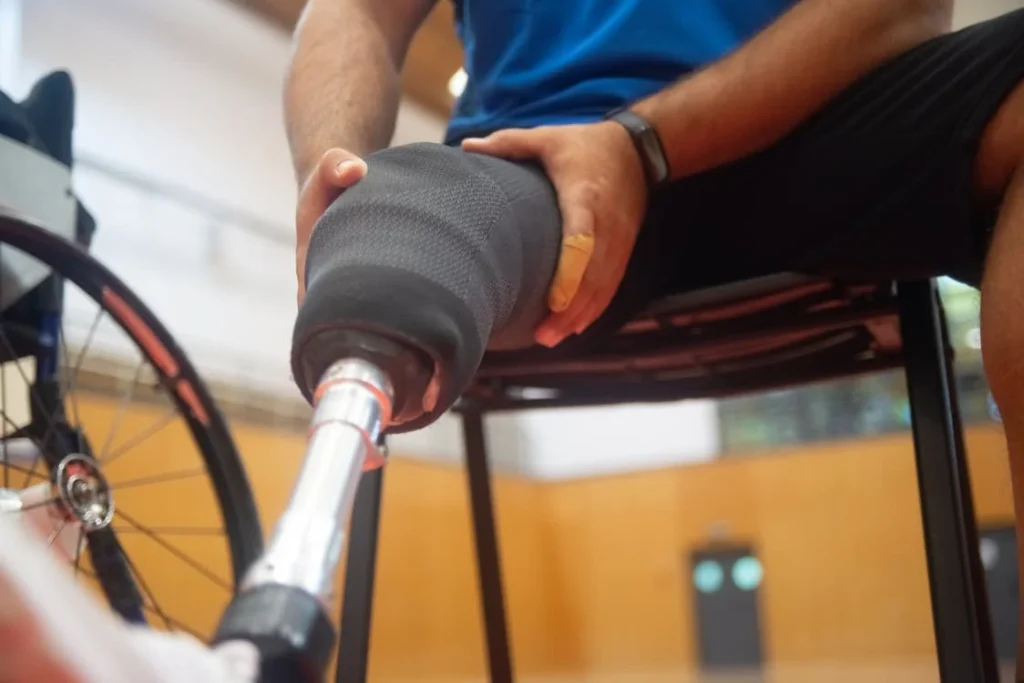
How Delayed Prosthesis Fitting Affects the Opposite Limb
When a person loses one limb, the remaining limb suddenly takes on a much bigger role. It becomes the primary source of balance, movement, and daily function.
While this compensation might feel natural at first, the body wasn’t designed to function that way for long. Delaying prosthesis fitting puts prolonged stress on the opposite limb—and that can create serious long-term consequences.
The Body Shifts into Overcompensation Mode
After an amputation, especially in the lower limb, people naturally lean more on the side that still has a full limb. For example, someone with a right leg amputation will instinctively put more weight on the left leg when walking, standing, or transferring from a bed or chair.
This overuse begins immediately after surgery and intensifies if a prosthesis is not introduced within a few weeks. Without the balance and support of a prosthetic limb, the remaining limb is forced to do the work of two.
Muscles become overused, joints take on added pressure, and the spine begins to adjust to an uneven gait.
This shift in biomechanics is the body’s way of trying to cope. But over time, this compensation becomes harmful. It creates muscle imbalances, joint pain, and strain that can turn into lasting damage.
Risk of Injury in the Sound Limb
One of the biggest dangers of long-term overcompensation is injury to the sound limb. Many patients report pain in the knee, ankle, or hip of their non-amputated side after just a few months of moving without a prosthesis.
This pain is not random—it’s a warning sign. The joints are being overused. The muscles are being stretched beyond their healthy limits. Without intervention, this can lead to ligament strain, joint wear, and even early arthritis.
In severe cases, the overuse becomes so intense that the sound limb becomes weak or unstable. This increases the risk of falls, which can cause further injuries and delay recovery even more.
A fall-related injury to the sound limb can quickly turn a manageable recovery into a crisis, sometimes leading to extended rehab or even a second disability.
All of this could be prevented or greatly reduced by introducing a prosthesis at the right time. A well-fitted limb restores balance and allows the person to distribute weight more evenly. It protects the sound limb and reduces the overall wear and tear on the body.
The Spine and Hips Take the Hit
It’s not just the limb that suffers when walking without a prosthesis. The entire alignment of the body is affected. When someone walks unevenly, the spine begins to curve slightly to compensate. One hip lifts higher than the other. One side of the back becomes tighter and more strained.
This can cause a condition known as pelvic tilt. It may start as minor discomfort, but it often leads to lower back pain, tight hamstrings, and reduced flexibility in the hips.
Over time, the asymmetry becomes more fixed, and walking—even with a prosthesis later—feels off-balance and uncomfortable.
Early prosthesis fitting prevents these postural changes from becoming permanent. When the body is allowed to move symmetrically early on, the spine, hips, and shoulders stay aligned. The result is not just better comfort, but a more natural and stable gait for life.
Mental Stress from Physical Discomfort
When the sound limb starts hurting or the back becomes stiff, the person starts to feel worn down—not just physically, but mentally. Pain in the sound limb creates anxiety. People begin to fear that they might lose their “good leg” too. This fear leads to hesitation, inactivity, and loss of motivation.
That emotional stress further slows recovery. It clouds decision-making and can reduce a person’s willingness to participate in therapy or wear a prosthesis even when it becomes available. In many ways, pain in the sound limb becomes a symbol of everything that’s gone wrong with the process.
When patients are fitted with a prosthesis on time, the stress on the sound limb is minimized. They move more comfortably, build confidence sooner, and avoid the emotional strain of worrying about further injury. The mind rests easier, and the focus stays on healing and moving forward.
Conclusion
Recovery after limb loss is not just about healing a wound—it’s about rebuilding a life. And one of the most powerful tools in that rebuilding process is a well-timed prosthesis. When fitting is delayed, the impact goes far beyond the leg or arm that’s missing. It affects muscles, joints, posture, balance, confidence, and even relationships. It places strain on the body, weighs on the mind, and slowly chips away at the momentum that’s so essential for recovery.
At Robobionics, we’ve seen what happens when fitting is delayed—and what happens when it’s done just right. The difference is not just in how a person walks, but how they feel about walking again. It’s the difference between feeling stuck and feeling ready. Between surviving and truly living.
That’s why timing matters. Not to rush, but to move with purpose. Not to pressure, but to protect progress. Every person deserves a prosthetic journey that respects their pace but doesn’t leave them behind. So, whether you’re a patient, a caregiver, or a medical professional, remember this: when it comes to prosthetic fitting, earlier isn’t just better—it’s life-changing.



